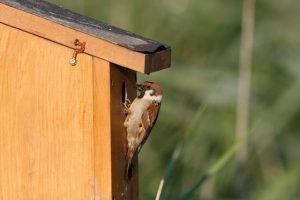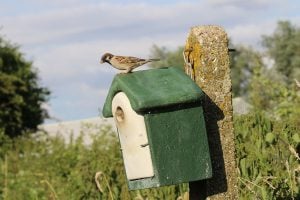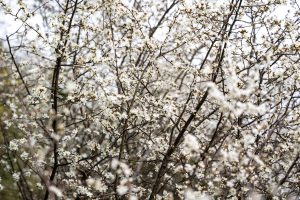What is National Nest Box Week and how can you get involved?
Have you been noticing an increase in birdsong recently? Well, there is a reason for this! This month you will begin to hear even more birds singing as they are establishing a breeding territory and are on a quest to attract potential mates to nest.
National Nestbox Week takes place every year from 14th - 21st February. The affair, that appropriately begins on Valentine’s Day, marks the beginning of the breeding season for birds and asks members of the public to set up nest boxes in their own gardens to help with this.
The event was started by the British Trust for Ornithology and is now an established part of the bird lovers calendar, running consistently for just over twenty years. We at Vine House Farm have always loved the initiative and that’s why we get behind it every year.

In today’s modern world, parks are cleaner, woodland areas have fewer mature trees and buildings are built smarter with fewer gaps and crevices. This causes a real issue for British garden birds. With the lack of natural holes, nooks and crannies our birds are in shortage of nesting holes, and because of this, the population of some bird species has decreased.
However, there are a few things we can do to help this with nestboxes being the most manageable. For those of us who have their own garden, we can replicate a natural nesting site by setting up our own nest boxes.
The two most important features of a good nestbox are shelter and security. Most nest boxes are either made from wood or woodstone (a mix of concrete and wood fibre). Both of these materials provide excellent insulation, which is vital for controlling temperatures both during the day and at night.
Furthermore, you must ensure that your nestbox is accessible, therefore we recommend that it is at least 150cm above the ground and that the box is large enough to accommodate your hand.
For a more in-depth guide to nest boxes, take a look at our guide here.

Different species of birds will prefer different types of nest boxes, which usually consist of an open-fronted nest box or one with a hole at the front. For birds which use a box with a hole at the front, the most important thing is the size of the hole.
Birds that favour small entrance holes (between 25mm and 28mm) include:
Birds that favour medium entrance holes (between 32mm and 45mm) include:
Birds that favour large entrance holes (45mm +) include:
For those species that prefer the open-fronted box, the size of the opening is much less of an issue and a ‘one size fits all’ approach can be used. Birds that favour these type of nest boxes include:

Nest boxes can be put up anytime throughout the year, however, autumn or early winter is best as many species of bird will start looking for a nest site as early as January. If you haven’t already set up your nest box, don’t panic there is still plenty of time to do so.
It’s also important to note that nest boxes can come in useful in your garden all year round as they can offer birds shelter and a warm place to sleep on cold nights.
Many people make the common mistake of placing their nest box in a location where they can easily watch the birds, and this can cause quite a few problems. The most vital factor when it comes to placing your nest box is to ensure that it is in a safe location where it is protected from predators and harsh weather conditions. We recommend positioning your nest box in a sheltered area facing north or northeast. This will protect it from direct sunlight coming from the south and wind and rain that usually come from the west.
In addition to this, make sure nest boxes with a front hole are placed at least 1.5 metres from the ground on tree trunks or on the side of a shed or well. Wherever you have placed it make sure the hole is free from any foliage that may obscure the entrance.
For open-fronted boxes, the opposite is needed. Make sure you place this type of nest boxes on a wall or fence that has shrubs or vegetation covering it as this will make it less noticeable to predatory birds.
Maintenance is key when it comes to looking after your nest box. Prior to each breeding season, it is important to clean out your nest box and ensure any damages are fixed or replaced with a new one.
When cleaning out an old nest it is a good idea to wear protective gear such as gloves and a dust mask. You can recycle old nests in your compost bin alongside any unhatched eggs.
Finally, we think that BTO's nest box challenge is a great initiative to get involved with. For one it helps the BTO gather important data on garden birds, plus it's also fun and interesting to take part in. So have a look at what's involved and get your nest boxes registered.
National Nestbox Week takes place every year from 14th - 21st February. The affair, that appropriately begins on Valentine’s Day, marks the beginning of the breeding season for birds and asks members of the public to set up nest boxes in their own gardens to help with this.
The event was started by the British Trust for Ornithology and is now an established part of the bird lovers calendar, running consistently for just over twenty years. We at Vine House Farm have always loved the initiative and that’s why we get behind it every year.

Why do nest boxes matter?
In today’s modern world, parks are cleaner, woodland areas have fewer mature trees and buildings are built smarter with fewer gaps and crevices. This causes a real issue for British garden birds. With the lack of natural holes, nooks and crannies our birds are in shortage of nesting holes, and because of this, the population of some bird species has decreased.
However, there are a few things we can do to help this with nestboxes being the most manageable. For those of us who have their own garden, we can replicate a natural nesting site by setting up our own nest boxes.
What makes a good nest box?
The two most important features of a good nestbox are shelter and security. Most nest boxes are either made from wood or woodstone (a mix of concrete and wood fibre). Both of these materials provide excellent insulation, which is vital for controlling temperatures both during the day and at night.
Furthermore, you must ensure that your nestbox is accessible, therefore we recommend that it is at least 150cm above the ground and that the box is large enough to accommodate your hand.
For a more in-depth guide to nest boxes, take a look at our guide here.

Which birds use nest boxes?
Different species of birds will prefer different types of nest boxes, which usually consist of an open-fronted nest box or one with a hole at the front. For birds which use a box with a hole at the front, the most important thing is the size of the hole.
Birds that favour small entrance holes (between 25mm and 28mm) include:
- Blue tit
- Nuthatch
- Coal tit
- Great tit
- House sparrow
- Marsh tit
- Tree sparrow
Birds that favour medium entrance holes (between 32mm and 45mm) include:
- Great spotted woodpecker
- Starling
Birds that favour large entrance holes (45mm +) include:
- Jackdaw
- Stock dove
- Tawny owl
For those species that prefer the open-fronted box, the size of the opening is much less of an issue and a ‘one size fits all’ approach can be used. Birds that favour these type of nest boxes include:
- Pied wagtail
- Robin
- Spotted flycatcher
- Wren

When’s the best time to put up a nest box?
Nest boxes can be put up anytime throughout the year, however, autumn or early winter is best as many species of bird will start looking for a nest site as early as January. If you haven’t already set up your nest box, don’t panic there is still plenty of time to do so.
It’s also important to note that nest boxes can come in useful in your garden all year round as they can offer birds shelter and a warm place to sleep on cold nights.
Where’s the best place to put your nest box?
Many people make the common mistake of placing their nest box in a location where they can easily watch the birds, and this can cause quite a few problems. The most vital factor when it comes to placing your nest box is to ensure that it is in a safe location where it is protected from predators and harsh weather conditions. We recommend positioning your nest box in a sheltered area facing north or northeast. This will protect it from direct sunlight coming from the south and wind and rain that usually come from the west.
In addition to this, make sure nest boxes with a front hole are placed at least 1.5 metres from the ground on tree trunks or on the side of a shed or well. Wherever you have placed it make sure the hole is free from any foliage that may obscure the entrance.
For open-fronted boxes, the opposite is needed. Make sure you place this type of nest boxes on a wall or fence that has shrubs or vegetation covering it as this will make it less noticeable to predatory birds.
How should you look after your nest box?
Maintenance is key when it comes to looking after your nest box. Prior to each breeding season, it is important to clean out your nest box and ensure any damages are fixed or replaced with a new one.
When cleaning out an old nest it is a good idea to wear protective gear such as gloves and a dust mask. You can recycle old nests in your compost bin alongside any unhatched eggs.
Support BTO’s Nest Box Week Challenge
Finally, we think that BTO's nest box challenge is a great initiative to get involved with. For one it helps the BTO gather important data on garden birds, plus it's also fun and interesting to take part in. So have a look at what's involved and get your nest boxes registered.



